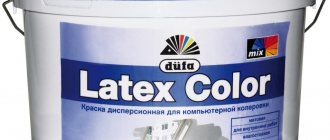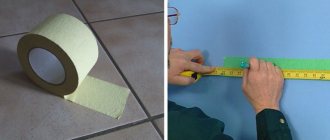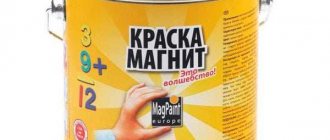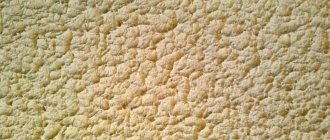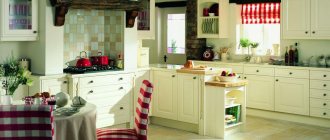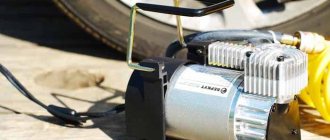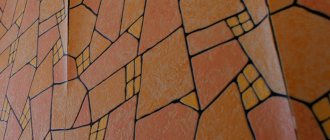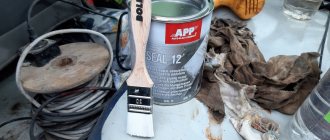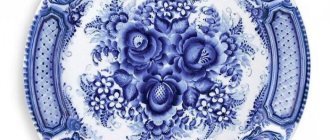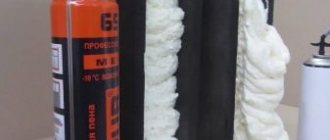Positive reviews
Painting canvas is an intermediate option between glass wallpaper and cobwebs in terms of cost and properties. But the manufacturing process uses the same raw material – fiberglass. According to users, the main positive feature is the ability of the material to undergo significant stretching, which distinguishes it from fiberglass analogues.
Painting non-woven fabric can be successfully used in places where large cracks have formed and there is a possibility of their development. As buyers emphasize, the material is produced in rolls of convenient size - 25 meters each. Among the advantages, home craftsmen and professional builders highlight the moderate cost and insignificant consumption of painting materials, which are applied during the decorative finishing process. Another advantage is the ability to stretch, which distinguishes the material from similar devices. The painting non-woven fabric has a smooth texture and also guarantees low glue consumption.
Area of use
If you are thinking about the question of what non-woven painting is needed for, then it is worth familiarizing yourself in more detail with the area of use of the material. This non-woven fabric is impregnated and is used for decorative finishing of ceilings and walls. The premises can have any purpose. In order to give the walls a smooth surface, non-woven fiber is successfully used, which has synthetic inclusions, due to which, after gluing the material, the surface becomes rough and acquires a relief structure.
Painting non-woven fabric, a photo of which is presented in the article, has a high forming ability, which allows you to mask rust, seams, and joints between panels on the ceiling and walls. At the same time, microcracks stop growing, and new ones do not form. Using this material, you can strengthen surfaces before painting, make the base mechanically strong and perfectly flat.
Construction interlining can replace finishing putty, which is also usually applied before the painting process. The material can be glued onto all types of plasters, plasterboard, porous concrete, plastic panels, wood, chipboard or fiberboard. Among other things, non-woven fabric can be glued to old wallpaper of any type, as well as old paint, which not only reduces the cost, but also makes repair work easier.
Reviews about safety of use
Painting non-woven fabric, reviews of which may help you make the right choice, is made from raw materials mainly of natural origin. The production process does not use heavy metals and their compounds, formaldehydes, mineral fibers or organic solvents. Users like that this repair material is non-toxic and does not release harmful substances into the environment. The material is characterized by high antifungal resistance, which helps combat the occurrence of mold. The repair canvas is characterized by high vapor permeability, which ensures a healthy indoor microclimate.
Compound
In the production of non-woven material, artificial fibers are used. The main composition of the interlining fabric is viscose. Since the material is non-woven, it does not have a transverse or longitudinal thread, however, craftswomen prefer to cut the reinforcing fabric lengthwise, since it stretches slightly in the transverse direction. According to GOST, adhesive interlining fabrics are marked like other fabrics. That is, the manufacturer must indicate the composition and care rules.
The paper-like substance is considered semi-synthetic. That is, cellulose fibers are diluted with polyester. However, 100% viscose varieties are also available on sale. By chemically modifying the fibers, it is possible to increase strength and wear resistance. Rigid modifications are characterized by high dimensional stability, are well painted and retain color, and are resistant to dirt.
Reviews about the technology of gluing non-woven fabric
Painting non-woven fabric, the density of which was mentioned above and can be selected by you depending on your goals, according to users, easily sticks to any surface. It is necessary to apply wallpaper glue to the base of the wall, and then apply dry interlining. Users claim that even after this, the stripes can be adjusted relative to each other, ensuring the accuracy of the location of the canvas. When gluing, the canvas is smoothed and straightened, even if the roll was stored in a deformed form. This makes it easier for the craftsman when he is trying to create a smooth surface.
Painting the walls
The most painstaking way is to paint the walls without using paintable non-woven fabric /paintable wallpaper/fiberglass. The walls are rendered “in glass” - into a perfectly flat and smooth surface without scratches. This is achieved by repeatedly alternating layers of finishing putty (shitrok is the most popular now, which is where “shitrot” comes from) and sandpaper.
But this method is not particularly recommended for apartments in new buildings, because... the house is still shrinking and cracks may appear. Therefore, in such situations, use a base for paint , which can “hold” small cracks, hide scratches from sandpaper and hairline cracks, and there is no need to carefully paint the walls under it. Let's talk about this method.
1. Painting non-woven fabric Sold in large rolls one meter wide and about 25 long, smooth without texture. It comes in different densities, the smaller the thinner and lighter it is. The higher the density, the heavier it is (more difficult to stick), but the stronger it is. The fabrics are glued end-to-end using non-woven glue. After gluing it should be given enough time to dry before painting. Glue them end-to-end, it’s better to let them separate a little than to end up with a “croaker”; you can always fill the seam with putty. Then the steps: 1.1 in one layer, paint only the seams. 1.2 sew the seams over the paint, without getting into unpainted areas. We remove excess putty with a spatula, running along the seam without strong pressure. 1.3 we sand, removing the extra “bump” and smoothing. if necessary, repeat steps 1.2-1.3 again if after sanding you could feel the seam with your finger. 1.4 paint the walls two layers. And now for him all this rigmarole? So that not a single seam is visible at the finish and the walls look like “just painted walls” and not non-woven fabric. Paint is needed so that when sanding the interlining itself is not damaged and its texture is preserved, paint makes it stronger. But this is a method either for perfectionists (yes, yes, that’s exactly what I did) or for those who messed up when gluing non-woven fabric (and it’s easier to mess up with a dense one))) If there is no such desire and you want something simpler and faster, then after gluing and Once dry, you can prime and paint.
2. Fiberglass (“spider web”) It’s a rather unpleasant thing for your hands, so you don’t need to work with it unless you’re wearing gloves, otherwise you’ll end up with a lot of scratches later))) The thin one is glued end-to-end, after drying it’s scratched + sanded two circles and then primed- puts on makeup.
3. Paintable wallpaper. There are different textures and patterns. In general, they are no different from ordinary non-woven wallpaper, except that they can be painted in any color and subsequently repainted. Glue, prime and paint in 2 layers.
Tricks: , a good primer can also help . For example, BM has an acrylic primer “fresh start”. Slightly whitish and thick, can be tinted. Thanks to its texture, it fills scratches and smoothes out unevenness a little. After this, paint consumption is noticeably reduced.
2. For the second option, you can use the same glue for non-woven fabric as a primer. Surely it will remain! Dilute it a little with water and that’s it - the primer is ready

